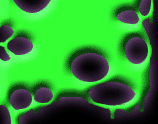|
Game: Sweet Home
Company: Capcom
System: Famicom
Year: Original Japanese Release December 1989, Translated
in English and was released June 15, 2000 only for emulation, c/o Gaijin Translations.
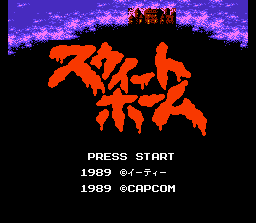
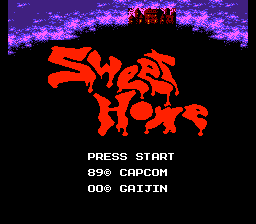
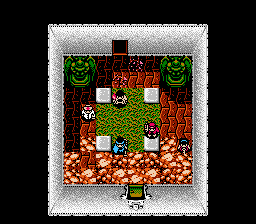


Here's something we didn't know. In Japan, looks like Capcom had a RPG that hit it big just a few years before Breath of
Fire. Forget Willow & Destiny of an Emperor. This Japan-only horror survival RPG, which is said to be based on a Japanese
horror flick that came out the same year as the game did, & a precursor of Resident Evil (It is, the gameplay from RE
all started in this, from reading notes scattered all over, to the "Will you open this door?" scenario, and even
the door opening cut scene from RE is straight from this) has the plot of a party of five set off to investigate an abandoned
mansion for a fresco but an evil spirit (which happens to be the ghost of the long deceased tenant of the manor) locks them
in, and now they're stuck in an endless labyrinth full of creatures and puzzles to solve. So each person in the group has
to use the skills of their professions to escape. Not only becuase they weren't sure if RPG games would get widespread attention
in the US compared to Japan back then, but because of the graphic, risque and shocking things seen in the game, like the monsters
you fight as your progress gets further, being able to talk to dead bodies lying around the mansion to get clues, results
of some puzzles, and the live death sequences that play when a character runs out of hitpoints, Nintendo of America rejected
Capcom to bring it over to the states.
Game: Final Fantasy II
Company: Square
System: Famicom
Year: December 1988
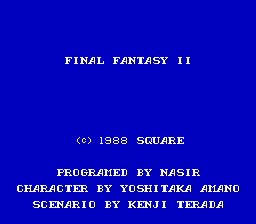
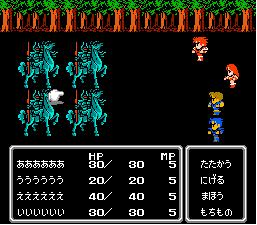
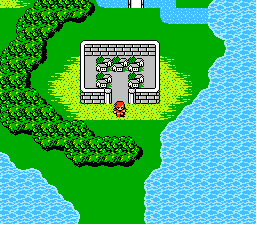
This is the first game out of the legendary role-playing series that never made it red-white and blue. The battle scenes
are arranged making the traditional look for all the following FF games unlike the "shelf screen" set up of the
first game. Also FF2j also makes the big break of "Chocobos", and starts the never ending FF tradition of using
the mainstay character name, "Cid".
Game: Final Fantasy III
Company: Square
System: Famicom
Year: April 27, 1990
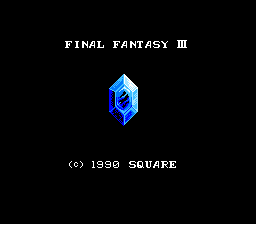
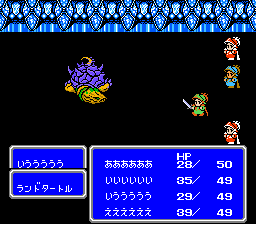
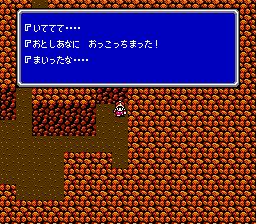
Once again people, another Final Fantasy game that's been rejected by the American game industry, because the Super Famicom
system was coming out also, and Square USA probably didn't think it was necessary to bring it to the US becuase the 16 bit
revolution was about to begin. But they could have brought it here just to keep players busy until the Super Nintendo came
out a year later. This one changed the look of the FF series from that point on. In other words, the menu layouts, and the
battle style that the American gamers first saw in FF2 on the Super Nintendo did start out on an 8-bit system. Also, this
Final Fantasy game marks the beginning of the mainstay trademarks and characteristics:
1. The first FF game where HP
damage/recovery numbers appear atop targets in battle.
2. Introduces the "Moogles". Yes. They did NOT start
in parts 5 and 6. Moogles first colonized the FF world on good ol' 8-bit.
3. Summon spells (including of course the legendary
Bahamut) make their big break here.
4. Introduces the huge variety of jobs and classes such as Dragoon, Caller/Summoner,
Geomancer, Archer, etc...
5. And as of music, it's also the first Final Fantasy game where boss battles have their own
theme as opposed to the first two FF's, as the same battle tune is played in both normal battles and bosses.
Game: Crisis Force
Company: Konami
System: Famicom
Release Date: August 27, 1991

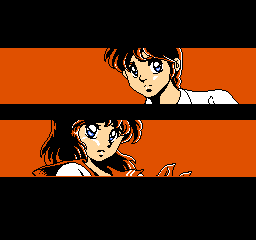
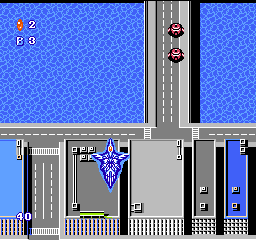
Another great Japanese shooter Konami kicked off the 1990's with. I don't
know what the storyline is, but everything about it is up there with all other Konami shooters: 2 player cooperative action,
you can blend into each other to make one big killer ship Twinbee style, and like all other Konami games, it's notorious for
having the best 8-bit music ever created. I'd hate to spoil this, but the music for the final battle will make your blood
rush!
Game: Lagrange Point
Company: Konami
System: Famicom
Release Date: April 26, 1991
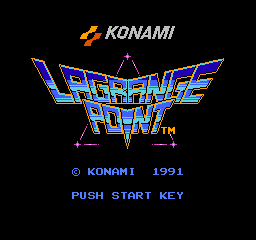
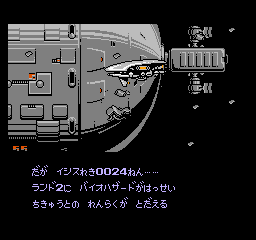
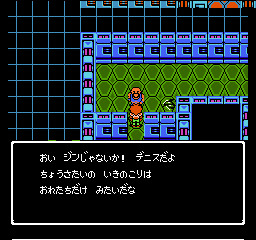
I can tell from the Crisis Force review that 1991 was a great year for Konami
of Japan. While we were stuck in America thinking all Konami made was action platformers, shooters and sports games, light
years before Konami made 32-bit RPG masterpieces such as Suikoden, Azure Dreams, and Vandal Hearts, they came out with Lagrange
Point, which is said to have been the "Star Ocean" of the 8-bit era. Again, I don't know any info about the storyline
of the game *hence the heavy Japanese text, hopefully someone will get off their ass and make a English translation patch
for this*. The battle system is first person like Dragon Warrior...well, I should really say Phantasy Star since
it has a futuristic space setting. And one OUTSTANDING thing about this game is the....not just the music but the quality
of the sound. Konami of Japan used a special sound chip called "VRC7" which added an extra channel to the original four, as
well as some excessive FM manipulation. The result: 16-bit quality sound, in the line between Sega Genesis and Turbografx
16! That deliberately defies the rules of 8-bit sound altogether!
Game: Alien Soldier
Company: Sega/Treasure
System: Mega Drive
Year: 1995
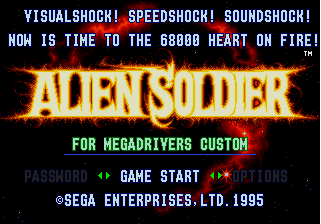
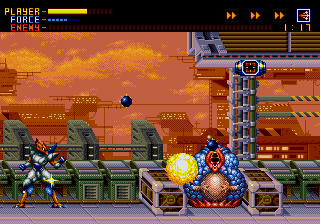
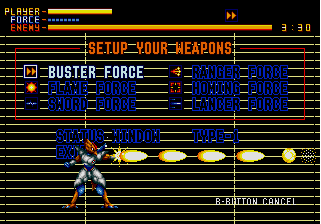
Alien Soldier, also made by Treasure, a side company known for their joints like Gunstar Heroes, Mischief Makers, and their
little thing with Konami for a couple of Contra games, would've been a major hit here in the United States. The gameplay
is excellent, just think Vectorman and Gunstar Heroes combined.
Game: Rockman Megaworld
Company: Capcom
System: Mega Drive
Year: 1994
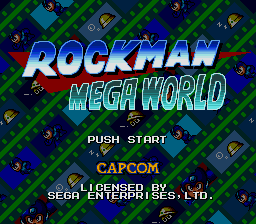
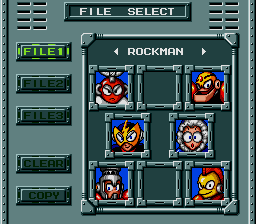
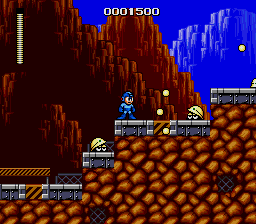
Actually, America has this as Mega Man: The Wily Wars, but the only way it was played was through the now ill-fated Sega
Channel. This is actually a revamped 16-bit compilation of the first three Mega Man games on the Nintendo Entertainment System.
All the stages and music are still the same, but enhanced.
Game: Front Mission
Company: Squaresoft
System: Super Famicom
Year: March 1995
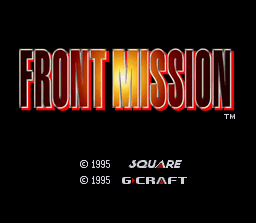
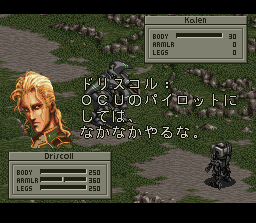
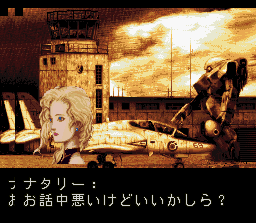
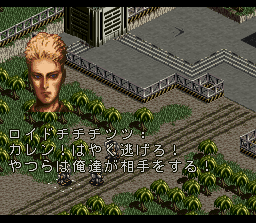
Here we go another Squaresoft masterpiece that didn't go red white and blue but many felt it deserved to. This military robotic
war strategy/RPG too could've been a major hit in 1995 if it made landfall in the United States with Chrono Trigger. Like
Final Fantasy, Front Mission has characters designed by Yoshitaka Amano, so no wonder the people in the second and third screens
look exactly like several characters from Final Fantasy 3/6, Edgar Figaro and Terra/Tina Branford, with a little Celes Chere
combined. Talk about separated-at-birth...
Game: Tales of Phantasia
Company: Namco
System: Super Famicom
Date: Late 1994
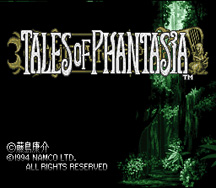
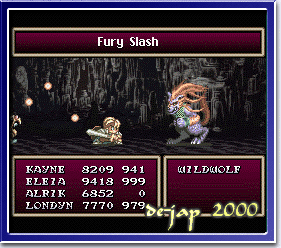
Another beautiful RPG masterpiece from Namco of Pac Man, Galaga, Galaxian
and Tekken fame. It has a real time fighting system meaning not menu driven, though it does put out a Final Fantasy-ish image. Tales
of Phantasia had also revealed a certain power in a SFC/SNES cartridge that NOBODY in America thought it would be capable
of: In Game Vocals, via the special sound system called the "Flexible Voice Driver", which also gave life to the vocal theme
soundtrack, "Yume wa Owaranai (The Dream Will Not Die)" which is heard in the intro.
Other miscellaneous things in Japan that the American game industry has denied us for wanting to enjoy:
> Wonderswan Color and the remakes of various Square classics. (The Famicom/Super Famicom Final Fantasy games, Front Mission,
etc...)
>Final Fantasy V...for Super Nintendo!! However back in 1994 when 16 bit ruled the gaming scene, there have
been rumors going around that Squaresoft USA was going to translate FF5 into English THEN, name it a totally different title
as if it wasn't part of the Final Fantasy series. Unfortunately, that idea was thrown out the door.
> Sega Saturn
versions of Capcom's CPS2 fighting games (X Men vs Street Fighter, Marvel Super Heroes vs Street Fighter, Vampire Savior,
Street Fighter Zero (Alpha) 3) and their 4-MEG RAM carts that were required to run them. What I think, these were released
when the Saturn was going downhill in the US. These games and the RAM carts could've granted the Saturn a little bit more
longevity. But noooo, Sega of America rejected the concept and just let the Saturn die, and we US gamers were left with the
nightmarish Playstation versions of Capcom's first three VS games. Shoot what the hell was the point in having a second fighter
since you can't crossover due to lack of memory inside the PSX? Well at least Sega made it up for us by letting Marvel vs
Capcom come on the Dreamcast.
>A RPG series that's been out since the Japanese PlayStation's debut half a decade
ago called "Arc the Lad". But I am happy to say that after over a few years later to this day, Working Designs has
finally decided to release for America a compliation of this series called the "Arc the Lad Collection".
>For
those that thought the Final Fantasy Legend series on Game Boy wasn't enough, we missed out on Square's other Japan-only Super
Famicom series "Romancing Saga". We could've have the experience of the Saga games before Saga Frontier came out
on the PSX.
>For Turbografx-16 owners: The PC Engine HuCard version of Street Fighter II Champion Edition and NEC's
six button controller. Before it's Japanese debut in 1993, this arcade/home translation on HuCard was once bound for the US.
Believe it or not, just months after the release it only sold for 26 (in US dollars that is).
> I know how angry disappointed
Dragon Warrior (Dragon Quest in Japan) fans were when the series ended at part 4 on the NES. It's a shame we had to miss the
Super Famicom Dragon Quest V and VI. All we've been getting was cheesy remakes of the NES DW games on the Game Boy Color.
Now what? Could the Dragon Warrior series suffer the territorial episode mix-up like the Final Fantasy series? (i.e PSX Dragon
Quest VII in Japan, Dragon Warrior V in the US.)
|

